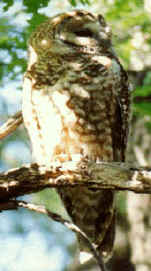Effects of Fire on Mexican Spotted Owls in Arizona and New Mexico

Thesis
![]()
The Effects of Fire on Mexican Spotted Owls in Arizona and New Mexico
Jeff Jenness
In 1993 the Mexican spotted owl (Strix occidentalis lucida) was listed as a threatened species by the US Fish and Wildlife Service, in part because of the rising potential threat to its habitat from catastrophic wildfires. Little research has been conducted to date examining the effects of fire on spotted owl presence and reproduction. In 1997 I surveyed 33 territories that had some level of fire in the previous 4 years, ranging from light controlled burns to near-total stand-replacing wildfire, and compared owl occupancy and reproduction in these burned territories to 31 unburned territories that had similar habitat and topography. The burned territories varied widely in terms of percent burned, severity of burn, cover type and topographic characteristics, so I also looked at trends of owl presence and reproduction in response to these variables. The presence of recent fire in a territory showed no evidence of affecting whether owls will be present or reproducing at that location (Sign test; p = 0.115). Discriminant function analysis and Multiple Response Permutation Procedures showed that the percentage of pine in a burned territory had the most influence on owl response, and that none of the fire severity variables had any significant and biologically interpretable influence on owl response. I attempted to find associations between fire severity and topographic/vegetative characteristics in spotted owl territories using Classification and Regression Trees (CART), but this analysis was severely limited by the lack of information on weather, climate and fuel moisture during the fire and results were inconclusive. Relatively light fires, including most prescribed fires, probably have no clear short-term positive or negative impact on Mexican spotted owl presence or reproduction, but they may indirectly benefit the owl by reducing the threat of potentially harmful wide-scale stand-replacing fires.
![]()